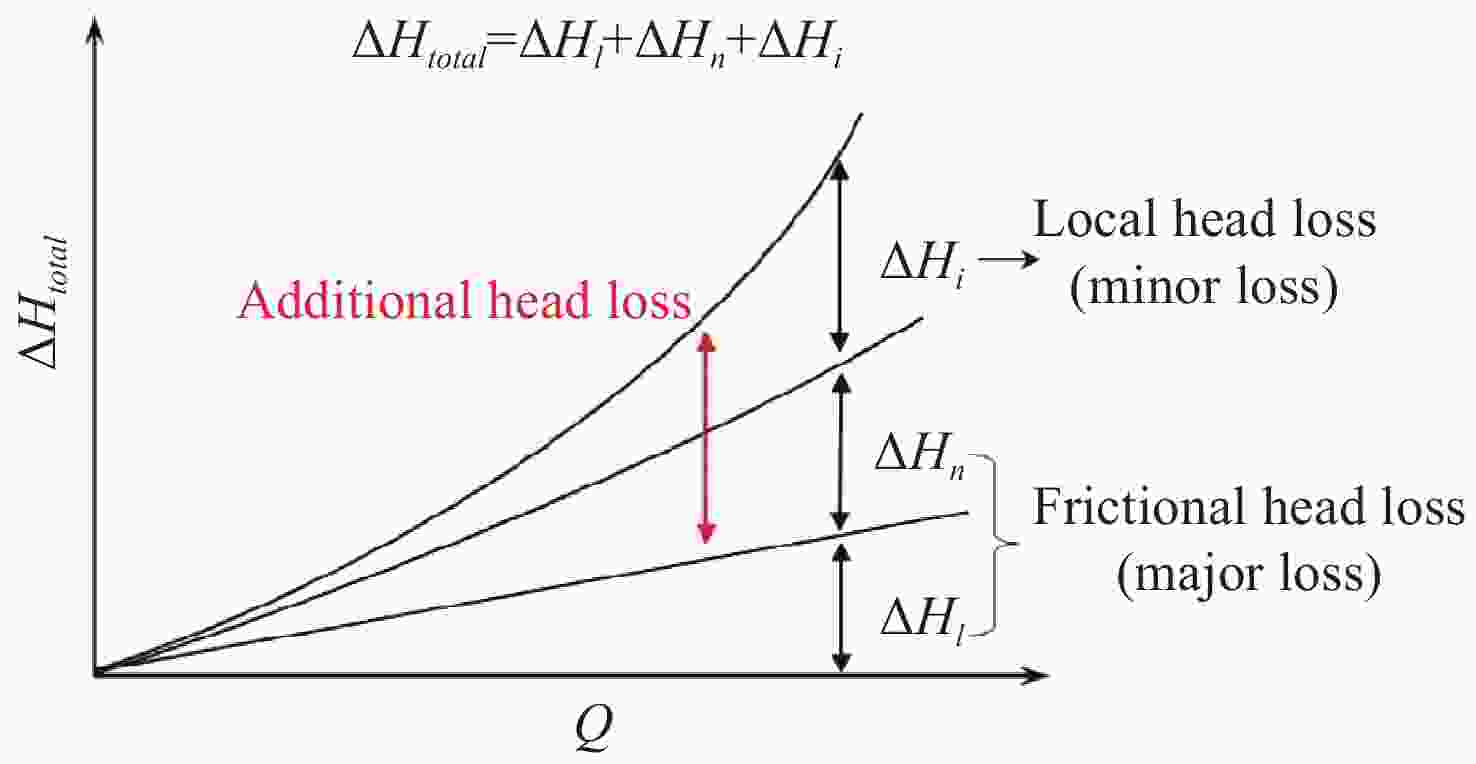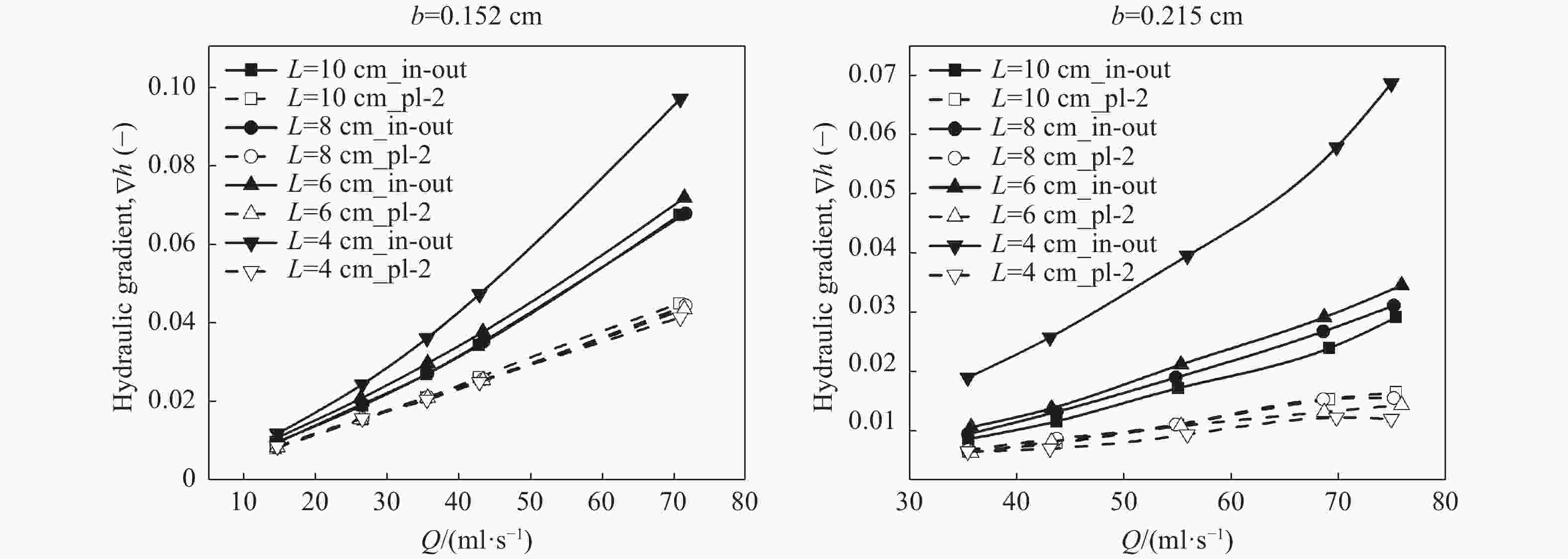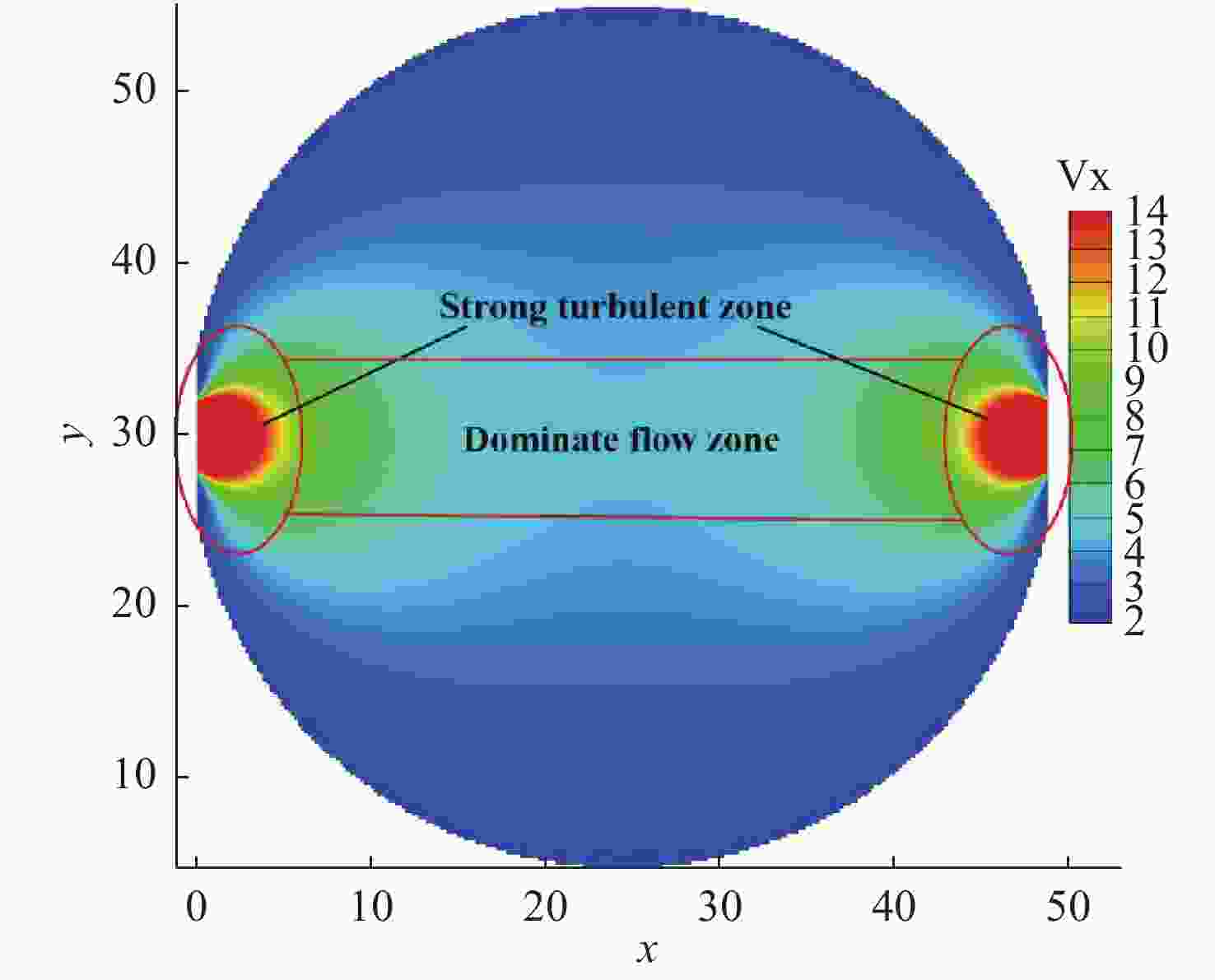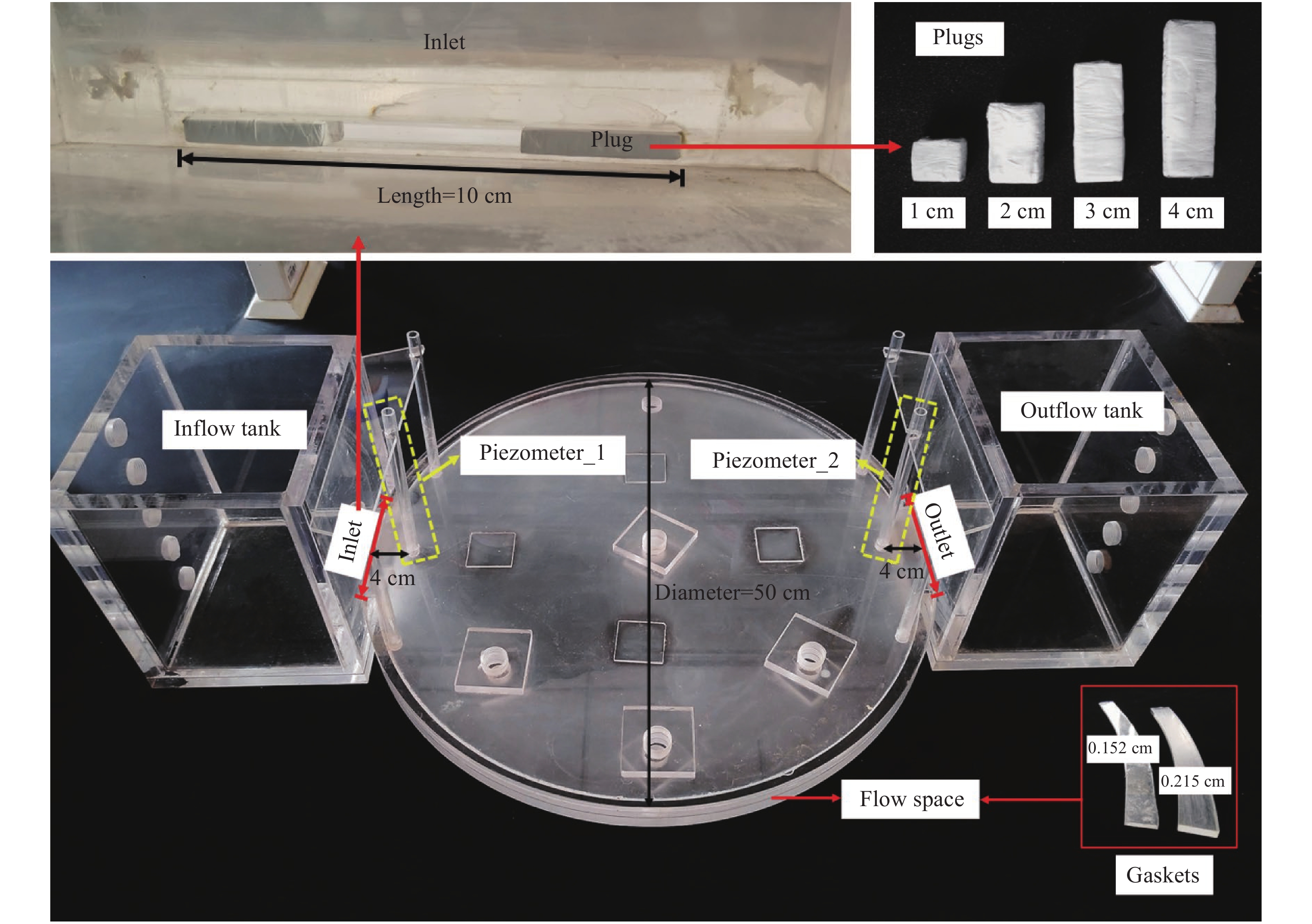Experimental and numerical investigation of groundwater head losses on and nearby short intersections between disc-shaped fractures
-
Abstract: Discrete fracture models are used for investigating precise processes of groundwater flow in fractured rocks, while a disc-shaped parallel-plates model for a single fracture is more reasonable and efficient for computational treatments. The flow velocity has a large spatial differentiation which is more likely to produce non-linear flow and additional head losses on and nearby intersections in such shaped fractures, therefore it is necessary to understand and quantify them. In this study, both laboratory experiments and numerical simulations were performed to investigate the total head loss on and nearby the intersections as well as the local head loss exactly on the intersections, which were not usually paid sufficient attention or even ignored. The investigation results show that these two losses account for 29.17%-84.97% and 0-73.57% of the entire total head loss in a fracture, respectively. As a result, they should be necessarily considered for groundwater modeling in fractured rocks. Furthermore, both head losses become larger when aperture and flow rate increase and intersection length decreases. Particularly, the ratios of these two head losses to the entire total head loss in a fracture could be well statistically explained by power regression equations with variables of aperture, intersection length, and flow rates, both of which achieved high coefficients of determination. It could be feasible through this type of study to provide a way on how to adjust the groundwater head from those obtained by numerical simulations based on the traditional linear flow model. Finally, it is practicable and effective to implement the investigation approach combining laboratory experiments with numerical simulations for quantifying the head losses on and nearby the intersections between disc-shaped fractures.
-
Figure 4. The relationships between the hydraulic gradient (
$ {\nabla \mathit{H}}_{\mathit{i}\mathit{n}-\mathit{o}\mathit{u}\mathit{t}\_\mathit{e}\mathit{x}\mathit{p}} $ and$ {\nabla \mathit{H}}_{\mathit{p}1-2\_\mathit{e}\mathit{x}\mathit{p}} $ ) and the flow rate (Q) in different experimental scenarios.Table 1. The parameters assigned in the corresponding numerical models
Parameters Units Values Boundary (flow in and flow out) Length (L) cm 10, 8, 6, 4 corresponding with each experiment Specified flux (Q) cm3/s corresponding with each experiment Aperture (b) cm 0.215, 0.125 corresponding with each experiment Reference fluid density ($ \rho ) $ kg/cm3 9.98E-4 Reference fluid viscosity (μ) kg/(cm·s) 9.53E-6 Acceleration due to gravity ($ g $) cm/s2 9.81E+2 Table 2. The experimental results of
$ {\Delta \mathit{H}}_{\mathit{i}\mathit{n}-\mathit{o}\mathit{u}\mathit{t}\_\mathit{e}\mathit{x}\mathit{p}} $ and$ \Delta {\mathit{H}}_{\mathit{p}1-2\_\mathit{e}\mathit{x}\mathit{p}} $ along with the percentage of$ \Delta {\mathit{H}}_{\mathit{s}\_\mathit{e}\mathit{x}\mathit{p}} $ to$ \Delta {\mathit{H}}_{\mathit{i}\mathit{n}-\mathit{o}\mathit{u}\mathit{t}\_\mathit{e}\mathit{x}\mathit{p}} $ b=0.152 cm b=0.215 cm Q
(cm3/s)$ {\Delta H}_{in-out\_exp} $
(cm)$ \Delta {H}_{p1-2\_exp} $
(cm)$ \dfrac{\Delta {H}_{s\_exp}}{\Delta {H}_{in-out\_exp}} $
(-)Q
(cm3/s)$ {\Delta H}_{in-out\_exp} $
(cm)$ \Delta {H}_{p1-2\_exp} $
(cm)$ \dfrac{\Delta {H}_{s\_exp}}{\Delta {H}_{in-out\_exp}} $
(-)L=10 cm 14.41 0.48 0.34 29.17% 35.34 0.45 0.29 35.56% 26.53 0.95 0.65 31.58% 43.55 0.60 0.35 41.67% 35.54 1.35 0.88 34.81% 54.91 0.88 0.48 45.45% 42.88 1.72 1.10 36.05% 69.03 1.22 0.66 45.90% 70.97 3.38 1.89 44.08% 75.28 1.48 0.71 52.03% L=8 cm 14.53 0.47 0.35 25.53% 35.28 0.49 0.30 38.78% 26.54 0.97 0.66 31.96% 43.57 0.68 0.38 44.12% 35.68 1.36 0.89 34.56% 54.70 0.97 0.48 50.52% 43.51 1.77 1.08 38.98% 68.48 1.36 0.66 51.47% 71.83 3.40 1.87 45.00% 75.06 1.58 0.67 57.59% L=6 cm 14.61 0.54 0.35 35.19% 35.58 0.55 0.28 49.09% 26.30 1.04 0.65 37.50% 43.10 0.71 0.36 49.30% 35.68 1.49 0.88 40.94% 55.17 1.08 0.47 56.48% 43.43 1.89 1.07 43.39% 68.55 1.48 0.57 61.49% 71.66 3.60 1.83 49.17% 75.78 1.75 0.62 64.57% L=4 cm 14.61 0.59 0.36 38.98% 35.25 0.97 0.29 70.10% 26.51 1.22 0.66 45.90% 42.94 1.31 0.31 76.34% 35.57 1.81 0.86 52.49% 55.76 2.00 0.41 79.50% 42.94 2.37 1.05 55.70% 69.71 2.92 0.53 81.85% 71.07 4.86 1.74 64.20% 74.82 3.46 0.52 84.97% Table 3. The derivate results of
$ {\Delta \mathit{H}}_{\mathit{i}\mathit{n}-\mathit{o}\mathit{u}\mathit{t}\_\mathit{d}\mathit{e}\mathit{r}} $ and the ratios of$ \Delta {\mathit{H}}_{\mathit{i}\_\mathit{d}\mathit{e}\mathit{r}} $ to$ \Delta {\mathit{H}}_{\mathit{i}\mathit{n}-\mathit{o}\mathit{u}\mathit{t}\_\mathit{e}\mathit{x}\mathit{p}} $ b=0.152 cm b=0.215 cm Q
(cm3/s)$ \dfrac{\Delta {H}_{in-out\_num}}{\Delta {H}_{p1-2\_num}} $
(-)$ \Delta {H}_{in-out\_der} $
(cm)$ \dfrac{\Delta {H}_{i\_der}}{\Delta {H}_{in-out\_exp}} $
(-)Q
(cm3/s)$ \dfrac{\Delta {H}_{in-out\_num}}{\Delta {H}_{p1-2\_num}} $
(-)$ \Delta {H}_{in-out\_der} $
(cm)$ \dfrac{\Delta {H}_{i\_der}}{\Delta {H}_{in-out\_exp}} $
(-)L=10 cm 14.41 1.46 0.49 0.00% 35.34 1.46 0.42 6.23% 26.53 1.46 0.95 0.44% 43.55 1.46 0.52 15.12% 35.54 1.46 1.28 5.15% 54.91 1.46 0.69 20.63% 42.88 1.46 1.60 6.94% 69.03 1.46 0.97 21.28% 70.97 1.46 2.74 18.65% 75.28 1.46 1.04 30.20% L=8 cm 14.53 1.52 0.54 0.00% 35.28 1.52 0.47 6.96% 26.54 1.52 1.00 0.00% 43.57 1.52 0.58 15.08% 35.68 1.52 1.36 0.55% 54.70 1.52 0.72 24.81% 43.51 1.52 1.65 7.27% 68.48 1.52 1.01 26.25% 71.83 1.52 2.84 16.42% 75.06 1.52 1.03 35.56% L=6 cm 14.61 1.61 0.57 0.00% 35.58 1.61 0.46 17.90% 26.30 1.61 1.05 0.00% 43.10 1.61 0.57 18.23% 35.68 1.61 1.41 4.76% 55.17 1.61 0.76 29.82% 43.43 1.61 1.73 8.70% 68.55 1.61 0.92 37.90% 71.66 1.61 2.96 18.02% 75.78 1.61 1.01 42.87% L=4 cm 14.61 1.76 0.63 0.00% 35.25 1.76 0.52 47.42% 26.51 1.76 1.16 4.85% 42.94 1.76 0.54 58.38% 35.57 1.76 1.51 16.44% 55.76 1.76 0.73 63.95% 42.94 1.76 1.85 22.09% 69.71 1.76 0.94 68.08% 71.07 1.76 3.06 37.05% 74.82 1.76 0.91 73.57% Major loss Minor loss $ \Delta {H}_{l} $ $ \Delta {H}_{n} $ $ \Delta {H}_{i} $ $ \Delta {H}_{in-out\_exp} $ √ √ √ $ \Delta {H}_{p1-2\_exp} $ √ √ $ \Delta {H}_{s\_exp} $ √ √ √ $ \Delta {H}_{in-out\_der} $ √ √ $ \Delta {H}_{i\_der} $ √ $ \Delta {H}_{in-out\_num} $ √ $ \Delta {H}_{p1-2\_num} $ √ -
Baecher GB, Lanney NA. 1978. Trace length biases in joint surveys, 19th U. S. Symposium on Rock Mechanics: 56–65. Bear. 1972. Dynamics of fluids in porous media, Dover Publications. Borgne TL, Bour O, Paillet FL, et al. 2006. Assessment of preferential flow path connectivity and hydraulic properties at single-borehole and cross-borehole scales in a fractured aquifer. Journal of Hydrology, 328(1-2): 347-359. doi: 10.1016/j.jhydrol.2005.12.029 Cacas MC. 1990. Modeling fracture flow with a stochastic discrete fracture network: Calibration and Validation 1. The flow model. Water Resources Research, 26(3): 491-500. doi: 10.1029/WR026i003p00491 Cao C, Xu ZG, Chai JR, et al. 2019. Radial fluid flow regime in a single fracture under high hydraulic pressure during shear process. Journal of Hydrology, 579: 124-142. doi: 10.1016/j.jhydrol.2019.124142 Dershowitz WS, Einstein HH. 1988. Characterizing rock joint geometry with joint system models. International Journal of Rock Mechanics and Mining Sciences & Geomechanics Abstracts, 21(1): 21-51. doi: 10.1007/BF01019674 Dverstorp B, Andersson J, Nordqvist W. 1992. Discrete fracture network interpretation of field tracer migration in sparsely fractured rock. Water Resources Research, 28(9): 2327-2343. doi: 10.1029/92WR01182 Gong Y, Mehana M, El-Monier I, et al. 2020. Proppant placement in complex fracture geometries: A computational fluid dynamics study. Journal of Natural Gas Science and Engineering, 79: 103295. doi: 10.1016/j.jngse.2020.103295 Grechka V, Kachanov M. 2006. Effective elasticity of rocks with closely spaced and intersecting cracks. Geophysics. 71: 85-91. Guo JC, Zheng J, Lyu Q, et al. 2020. A procedure to estimate the accuracy of circular and elliptical discs for representing the natural discontinuity facet in the discrete fracture network models. Computers and Geotechnics, 121: 103483. doi: 10.1016/j.compgeo.2020.103483 Hartley L, Roberts D. 2013. Summary of discrete fracture network modelling as applied to hydrogeology of the Forsmark and Laxemar sites, Swedish: 8-9. Hunter Rouse. 1946. Elementary mechanics of fluids. New York, John Wiley & Sons, Inc. Chapter, 7: 192-226. Hu YJ, Mao GH, Cheng WP, Zhang JJ. 2005. Theoretical and experimental study on flow distribution at fracture intersections,. Journal of Hydraulic Research, 43(3): 321-327. doi: 10.1080/00221680509500126 Jing LR. 2007. The basics of fracture system characterization – Field mapping and stochastic simulations. Developments in geotechnical engineering, 85: 147-177. doi: 10.1016/s0165-1250(07)85005-x Johnson J, Brown S, Stockman H. 2006. Fluid flow and mixing in rough-walled fracture intersections. Journal of Geophysical Research: Solid Earth, 111(B12). Kemler E. 1933. A study of the sata on the flow of fluid in pipes. Transactions of the ASME. 55 (Hyd-55-2): 7–32. Kolditz O. 2001. Non‐linear flow in fractured rock. International Journal of Numerical Methods for Heat & Fluid Flow, 11(6): 547-575. doi: 10.1108/eum0000000005668 Koudina N, Gonzalez Garcia R, Thovert JF, et al. 1998. Permeability of three-dimensional fracture networks. Physical Review E, 57(4): 4466-4479. doi: 10.1103/physreve.57.4466 Lei Q, Latham JP, Tsang CF. 2017. The use of discrete fracture networks for modelling coupled geomechanical and hydrological behaviour of fractured rocks. Computers and Geotechnics, 85: 151-176. doi: 10.1016/j.compgeo.2016.12.024 Liu R, Jiang Y, Li B. 2016. Effects of intersection and dead-end of fractures on nonlinear flow and particle transport in rock fracture networks. Geosciences Journal, 20(3): 415-426. doi: 10.1007/s12303-015-0057-7 Long JCS, Gilmour P, Witherspoon PA. 1985. A model for steady fluid flow in random three-dimensional networks of disc-shaped fractures. Water Resources Research, 21(8): 1105-1115. doi: 10.1029/wr021i008p01105 Moody LF, Princeton NJ. 1944. Friction factors for pipe flow. Transactions of the ASME, 66: 671-684. Petchsingto T, Karpyn ZT. 2009. Deterministic modeling of fluid flow through a CT-scanned fracture using computational fluid dynamics. Energy Sources, Part A: Recovery, Utilization, and Environmental Effects, 31(11): 897–905. Pollard DD. 1976. On the form and stability of open hydraulic fractures in the earth’s crust. Geophysical Research Letters, 3(9): 513-516. doi: 10.1029/GL003i009p00513 Pruess K. 1998. On water seepage and fast preferential flow in heterogeneous, unsaturated rock fractures. Journal of Contaminant Hydrology, 30(3-4): 333-362. doi: 10.1016/s0169-7722(97)00049-1 Reza J, Maria K et al. 2018. A multi-scale approach to identify and characterize preferential flow paths in a fractured crystalline rock. Proceedings of the 52nd U. S. Rock Mechanics/Geomechanics Symposium 17-20, Seattle: Washington. Su GW, Geller JT, Pruess K et al. 2001. Solute transport along preferential flow paths in unsaturated fractures. Water Resources Research, 37(10): 2481-2491. doi: 10.1029/2000wr000093 Tuckwell GW, Lonergan L, Jolly RJH. 2003. The control of stress history and flaw distribution on the evolution of polygonal fracture networks. Journal of Structural Geology 25(8): 1241–1250. Vu MN, Pouya A, Seyedi DM. 2018. Effective permeability of three-dimensional porous media containing anisotropic distributions of oriented elliptical disc-shaped fractures with uniform aperture. Advances in Water Resources, 118: 1-11. doi: 10.1016/j.advwatres.2018.05.014 Wang M, Kulatilake PHSW, Um J, et al. 2002. Estimation of REV size and three dimensional hydraulic conductivity tensor for a fractured rock mass through a single well packer test and discrete fracture fluid flow modeling. International Journal of Rock Mechanics and Mining Sciences, 39(7): 887-904. doi: 10.1007/s00603-018-1422-4 Wang Y, Liu YG, Bian K, et al. 2020. Seepage-heat transfer coupling process of low temperature return water injected into geothermal reservoir in carbonate rocks in Xian County, China. Journal of Groundwater Science and Engineering, 8(4): 305-314. doi: 10.19637/j.cnki.2305-7068.2020.04.001 Wilson CR, Witherspoon PA. 1976. Flow interference effects at fracture intersections. Water Resources Research, 12(1): 102-104. doi: 10.1029/wr012i001p00102 Witherspoon PA, Wang JSY, Gale JE. 1980. Validity of cubic law for fluid flow in a deformable rock fracture. Water Resources Research, 16(6): 1016-1024. doi: 10.1029/WR016i006p01016 Xiong F, Wei W, Xu C, et al. 2020. Experimental and numerical investigation on nonlinear flow behaviour through three dimensional fracture intersections and fracture networks. Computers and Geotechnics, 121, May 103446. Zimmerman RW, Al-Yaarubi A, Pain CC, et al. 2004. Non-linear regimes of fuid fow in rock fractures. International Journal of Rock Mechanics and Mining Sciences, 41(1): 1-7. doi: 10.1016/j.ijrmms.2004.03.036 Zhang Z, Nemcik J, Ma S. 2013. Micro- and macro-behaviour of fluid flow through rock fractures: An experimental study. Hydrogeology Journal, 21(8): 1717-1729. doi: 10.1007/s10040-013-1033-9 -

 E-mail alert
E-mail alert Rss
Rss



 下载:
下载:






























